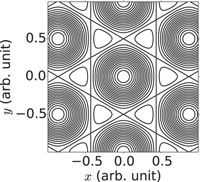No CrossRef data available.
Article contents
Graphene electronic structure in charge density waves
Published online by Cambridge University Press: 17 July 2017
Abstract

We introduce the idea that the electronic band structure of a charge density wave system may mimic that of graphene. In that case, a class of materials quite different from graphene might be opened up to exploit graphene’s remarkable properties. For such materials, their dynamical rather than static properties are crucial. The charge density wave system requires a wave geometry simply related to graphene and self-consistency among the electrons which requires the net Coulomb and phonon-mediated parts of the electron–electron interactions to be attractive. Our model leads to an analytical expression for the total energy in terms of the effective electron mass µ, the electron density ρ0, and the strength  ${\tilde v_K}$ of the net electron–electron interaction. We examine the limitations set upon
${\tilde v_K}$ of the net electron–electron interaction. We examine the limitations set upon  ${\tilde v_K}$ by self-consistency, stability, and the approximation in the electronic state calculation and find them to be mutually compatible.
${\tilde v_K}$ by self-consistency, stability, and the approximation in the electronic state calculation and find them to be mutually compatible.
- Type
- Articles
- Information
- Copyright
- Copyright © Materials Research Society 2017
Footnotes
Contributing Editor: Susan B. Sinnott



